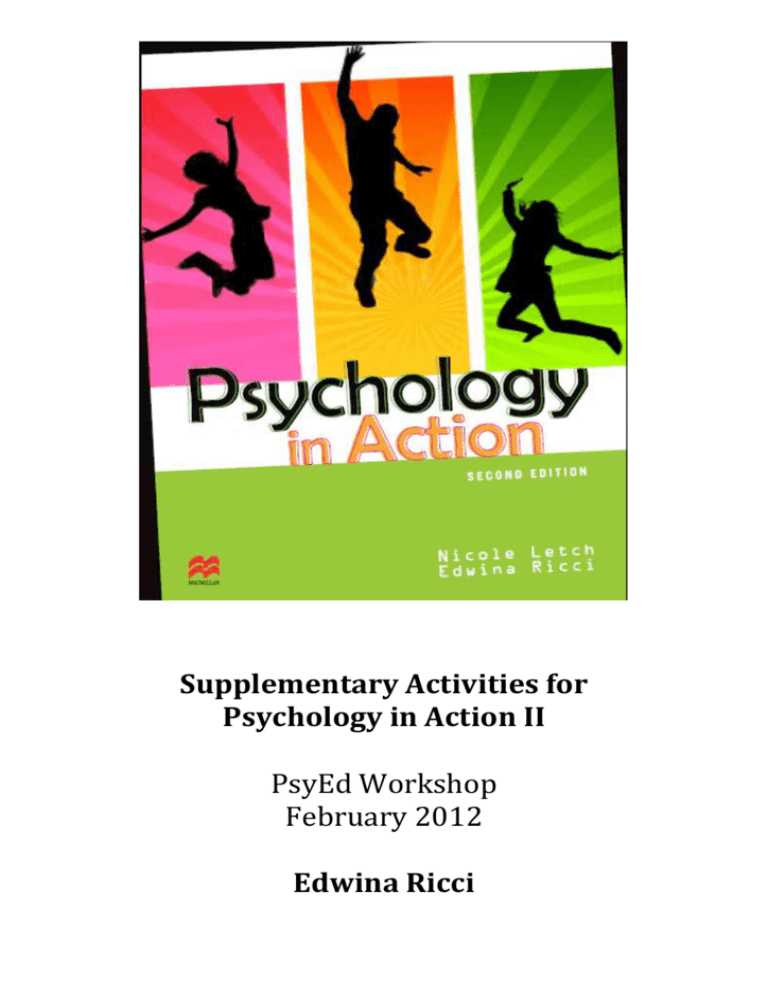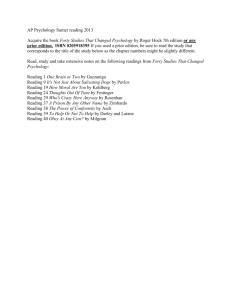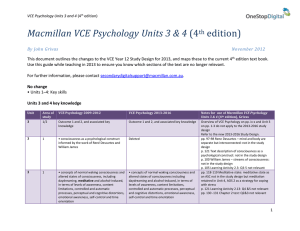Supplementary Activities for year 10
advertisement

Supplementary Activities for Psychology in Action II PsyEd Workshop February 2012 Edwina Ricci Activities have been described under each module heading. Some of these are an extension of what you’ll find in the book, others are to extend some of the concepts to get students thinking more deeply about a topic. Highlighted in red are the additional activity sheets that will be contained on the CDES conference disc under each Module heading. Module One: What is Psychology? * Top 10 Unethical Psychological Experiments Learning Intentions: To understand the seven steps of the scientific method To understand that there is a code of ethics that is applied to all research in determining whether a particular study can be conducted or not To explore in depth 3 different case studies where there were breaches of the code of ethics. These breaches should be identified and explained in context of each experiment. * What would happen if students went screen-free for a week? Students at Brentwood Secondary College found out what it was like to go “screenfree” by giving up TV, texting, the computer, ipods/iphone and gaming consoles. The article gives an overview of the outcomes of the study. As part of the introduction to Year 10 Psychology and Research Methods it would be good to conduct your own study where students keep a journal of each day and record how long they last. A discussion of the 7 steps of scientific method (page 29-33) could be conducted and students could work through the write-up using a prescribed format that would be used in VCE Psychology. (Report of Findings) See Article about the Brentwood SC experiment Module Two: Sport Psychology Brainology http://www.brainology.us/ Introducing Brainology, an online course for students that helps them discover that they are not born with their talents, rather they are grown via many hours of practice. Malcolm Gladwell in his book “Outliers” describes how everyone from The Beetles to Bill Gates were not born with their genius or natural abilities, rather it was circumstance that enable them to hone their talents for 10,000 hours – resulting in them becoming experts in their fields of music and computers. Prof. Carol Dweck of Standford University developed the course to teach students that their own talents and intelligence can be “grown” using the latest neuroscience research. I have attached some of the documents that you can freely download from the Brainology website. Chapter 6 - MOTIVATION Given it is an Olympic year it is an opportunity for students to select an athlete of interest via the Australian Olympic Committee website: http://london2012.olympics.com.au/ Write a 500-word biography of your athlete of choice. It could be Matthew Mitcham or Steve Hooker or one of the many athletes you will find on the AOC website. Your goal is to find out what motivates them to be the top of their sport. Chapter 7 - Arousal and Sporting Performance Class Activity: Estimating the speed of neural transmission Arrange ten people (or the whole class) sitting in a line on the floor, with each person holding the ankle of the next person. Gently squeeze the ankle of the first person in the line and simultaneously start a stopwatch. As the person feels the squeeze, they should squeeze the ankle of the next person and so on down the line like a chain reaction. When the last person in the line feels the squeeze they should say “now” and the timer should be stopped immediately. This procedure should be repeated a few times until the results are consistent. To get an approximate measure of speed of the neural impulse of individuals, calculate the mean time taken, by dividing the total time taken by the number of individuals who participated. As a comparison, repeat the procedure, with participants squeezing the hand or shoulder of the next person. How do you think this time will compare to the original? Explain. Source: Psychology for the VCE student 4th Edition – Grivas and Carter Extension to Activity Students could put together a powerpoint/slide show of sporting images and their motivational song of choice. The class could then rate each one for their motivational value?? Additional Resource: http://www.fuel-my-motivation.com/motivational-songs-4.html Inspiring Sporting Movies: Students could choose their favourite and the class watch the most popular one OR the class watch the most recent sports movie – INVICTUS. Examples: Invictus (2010) – rugby Raging Bull (1980) – boxing Rocky (1976) – boxing Million dollar baby (2006) – boxing National Velvet (1944) Chariots of Fire (1981) – athletics Jerry Maguire (1996) – American football Cinderella Man (2005) – boxing Any given Sunday (1999) - American football Remember the Titans (2000) - American football A League of their own (1992) – Baseball Coach Carter (2005) – Basketball The Blindside (2009) – American football Module Three: Clinical Psychology Activity on Systematic Desensitisation (page 177) – a method for treating phobias. This will be taught again in year 12 as part of the Mental Health AOS. See Activity Sheet Ben Cousins story on addiction: http://au.news.yahoo.com/thewest/a/-/wa/12591119/cousins-in-psychiatric-unit/ Module Four: Forensic Psychology Class Activity: Port Arthur Massacre – fact or fiction? – page 226 Using the information from http://www.whale.to/b/viallspam.html, the text and the book “Born or Bred?”, students should explore the contradictory account of events from Port Arthur and bring evidence to class to be discussed against the official documented evidence as stated on pages 226-227. Teachers may want to divide the class in half, getting some to research the events via one source and the other half the alternate viewpoint. New to psychology in Action II – Fast Lane – Short movie Module Five: Educational and Developmental Psychology AN ADDITIONAL RESOURCE " Synopsis Move over, Freud, there's a new psychologist in the forest, and his name is Winnie-the-Pooh. In this witty book, Williams cleverly explores the psychological depths of the inhabitants of the Hundred Acre Wood: Piglet is compulsively shy, Eeyore is clinically depressed, and so on. In his unobtrusive way, Pooh is at the centre of the puzzle, teaching each of his friends a little about themselves and leading them on the road to recovery. Chapter 19 – PLAY It’s a few years now since PLAY was on the VCE curriculum so appropriate to include in this module. If you want to refer to prior VCE information then a suggested additional resource is Grivas and Carter VCE for Untis 1 and 2 1st Edition. Chapter 7 – Play and Social Behaviour. Extension Activity: All I want for Christmas………My Favourite Play Activity Timeline Students should prepare a poster to represent their play activities over time – one year intervals. As all students are roughly the same age it is likely that they played with similar “it” toys in the same year of their development. Students are to go back as far as they can remember – suggested ages 3 or 4 and write down what their favourite toy or play activity was at the time. Teachers could suggest they use birthday parties and Christmas to prompt their memories. Students should prepare a poster or presentation to be presented to the class. As an extension to the activity a comparison between boys and girls could be made if both represented in your class and also between members for similarities and differences. A final activity could be to create a “class” timeline with agreed activities by year – these could then be compared to another class. Onomatopoeia Poems Noises By Danielle Caryl The click of the clock, the creak of the stair, The squeak of a mouse and the swoosh of the air. The groan of the house as it settles below, And outside the window, the patter of snow. The scruff of the dog's paws below where I rest, The rattle of the window that seems to face West. The jingle of bells from a wind chime next door The unearthly sounds of a truly loud snore. The crunching of snow under an animal's feet, The honk of a horn from right down the street. So many noises I just want to weep, Is it too much to ask for some sleep? I Know All the Sounds The Animals Make Reader 1: I know all the sounds that the animals make, Reader 2: And make them all day from the moment I wake, Reader 1: I roar like a mouse, and I purr like a moose, Reader 2: I hoot like a duck and I moo like a goose. Reader 1: I squeak like a cat and I quack like a frog, Reader 2: I oink like a bear, and I honk like a hog. Reader 1: I croak like a cow, and I bark like a bee. Both Readers: No wonder the animals marvel at me! Chapter 21 – An additional resource for the study of Aspergers. All cats have Asperger Syndrome is an analogy to help explain the disorder to someone with little or no knowledge of what it is. Unlike dogs, who thrive on attention and love and pursue it with big brown eye contact, cats are noted and even revered for taking and giving affection purely on their own terms. We expect felines to be a little prickly, a little quirky; it's in their nature to look at humans with a skeptical eye and an air of "What are you on about?" Children with Asperger syndrome may not be as fuzzy and cuddly as the kitties in the photos that fill this book, but it's easy and somewhat enlightening to think of their puzzlement at silly human social customs and cautions as being calculatedly catlike.





